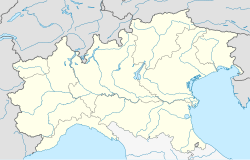 | |||||||||||
| General information | |||||||||||
| Location | Via Ferruccio Parri at Via Bisceglie, Milan | ||||||||||
| Coordinates | 45°27′20″N9°06′48″E / 45.45556°N 9.11333°E | ||||||||||
| Owned by | Azienda Trasporti Milanesi | ||||||||||
| Platforms | 2 | ||||||||||
| Tracks | 2 | ||||||||||
| Connections | ATM buses | ||||||||||
| Construction | |||||||||||
| Structure type | Underground | ||||||||||
| Parking | 1400 spaces | ||||||||||
| Accessible | yes | ||||||||||
| Other information | |||||||||||
| Fare zone | STIBM: Mi1 [1] | ||||||||||
| History | |||||||||||
| Opened | 21 March 1992 | ||||||||||
| Services | |||||||||||
| |||||||||||
| |||||||||||
Bisceglie is a station on Line 1 of the Milan Metro in Milan, Italy. The station opened on 21 March 1992 as a one-station extension from Inganni. It is the western terminus of the branch. [2] The station is located between Via Bisceglie and Via Ferruccio Parri, within the municipality of Milan.
This terminus station provides a connection to local and intercity buses operated by ATM at an adjoining bus station.



